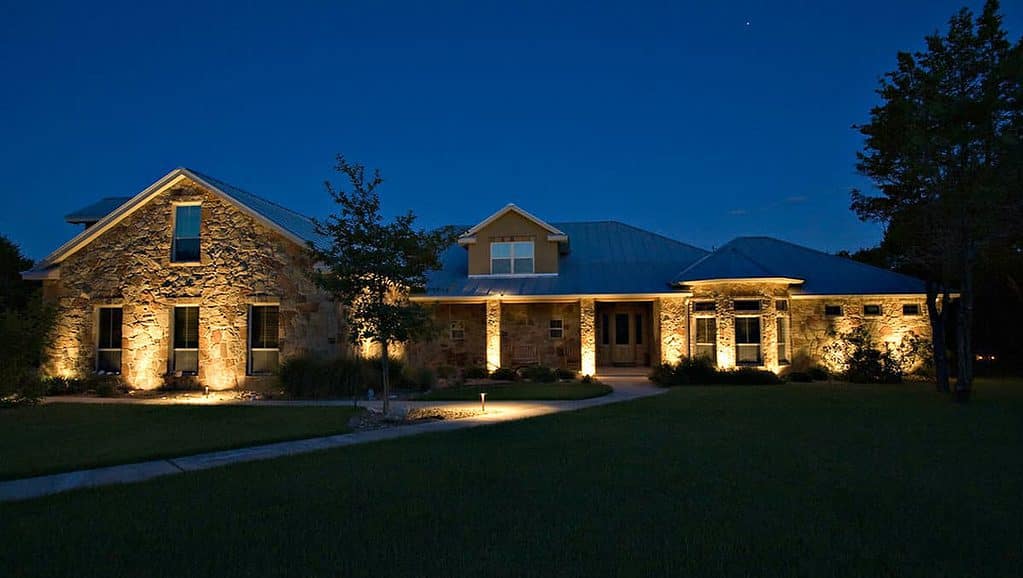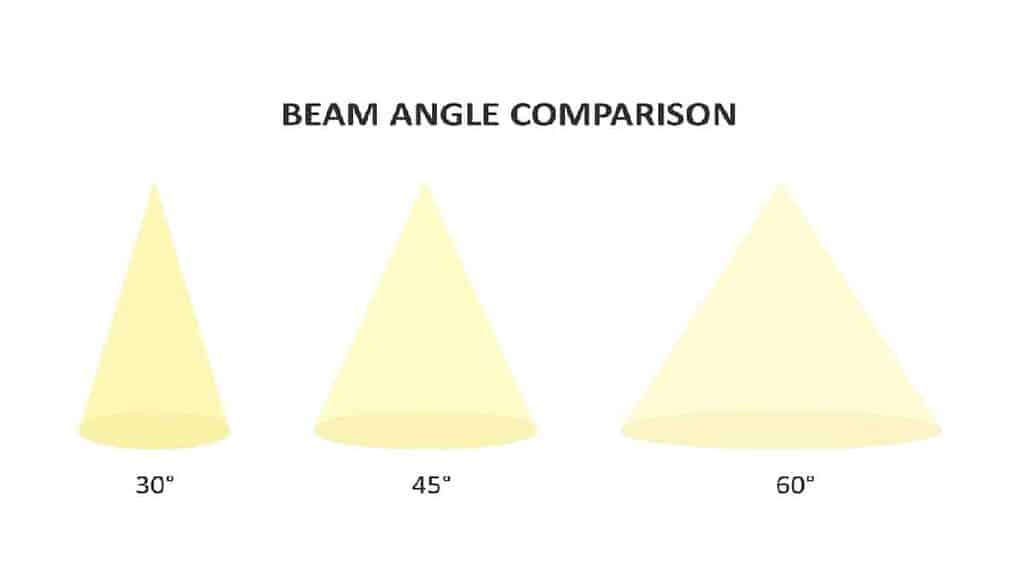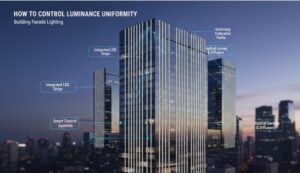Understanding Foot Candles and Illuminance
The illumination capacity of a light fixture is determined by the brightness of the bulb, its beam angle, and the distance from the subject. Foot-candle (fc) measures the light level relative to the distance from the light source.

Foot-Candle (fc)
A light bulb rated at one foot-candle can light up one square foot of surface with a light output of one lumen (lm). While foot-candle (fc) is a relative illumination measurement, lumens (lm) measure the total light output from the source.
In short, the foot-candle measurement will change as the subject moves away from the source. However, the source’s lumen output will always remain the same, irrespective of distance.
Light Level in Lux
Similar to foot-candle, lux is a relative measure of light levels. It is defined as one lumen covering one square meter of area.
1 Foot-Candle = 10.7639 Lux
Businesses looking to illuminate their outdoor space must maintain a minimum level of brightness, measured in lux or fc. Low lighting levels can lead to accidents, especially in high-risk areas, such as parking lots and staircases.
Lighting Uniformity Ratio
Another key element of outdoor lighting is uniformity. Lighting uniformity refers to the evenness of illumination across a select area. If a room has no dark spaces and every square foot has the same light level, then that room has ideal lighting uniformity.
A good uniformity ratio ensures a smooth transition from high- to low-brightness regions. Low uniformity means sudden shifts in brightness levels, which cause eye strain and compromise visibility.
Lighting or Illumination Uniformity is the ratio between the area’s minimum light level (Emin) and average light level (Eav).
Uniformity Ratio (d) = E min / E av
To ensure public safety and lighting quality, businesses should consider the uniformity ratio in their outdoor lighting design.
Recommended Outdoor Lighting Levels

Lighting level recommendations depend on the specifics of your outdoor lighting application. Luckily, the Illuminating Engineering Society of North America (IESNA) has outlined easy-to-understand recommendations for exterior lighting.
European & UK businesses can look to the BS EN 12464 standards that outline lighting practices that balance visual comfort with performance.
Before we jump to a specific application, it is important to mention that the general outdoor lighting guidelines are 10-20 foot candles (~100-200 lux). For any application not covered in this section, consumers should stick to the recommended 10-20fc.
1. Parking Areas
Parking lots can be divided into three categories based on the number of people expected in the space.
- High-activity parking lots outside major sports fields, cultural events, or mega malls should have an average light level of 3.6 foot candles.
- Medium-activity parking lots include areas outside of airports, hospitals, residential buildings, and recreational events. These areas must have an average light level of 2.4 foot candles.
- Low-activity parking includes industrial parking areas, education facilities, places of worship, neighborhood stores, etc. Such parking areas only need an average illumination of 0.8 foot candles.
The recommended uniformity ratio for parking areas is 0.25, irrespective of their activity level.
2. Sports Field
Sports lighting design prioritizes athlete safety and field visibility.
- Amateur games only need 20-50 fc. of illuminance, depending on field size.
- Professional games, especially ones that will be televised, require higher illuminance (50-75 fc) to ensure fair play and compatibility with modern camera equipment.
Modern digital cameras give the best results under good lighting conditions. Thus, LEDs with high-lumen output are necessary for professional games.
3. Building Exterior
Buildings come in all sizes and shapes and serve different purposes. You can determine the suitable exterior light level by looking at the pedestrian presence outside.
- Active areas with many people walking around should have an average illumination of 5 fc.
- Inactive areas with few to no people, such as locked building entrances/exits, require illumination of 1 fc.
- Vital locations such as valet parking outside restaurants and hotels, bus stands, and entrance areas should also be illuminated at 5 fc.
- The remaining areas surrounding the building need minimum illumination at night (1 fc.).
4. Parks and Gardens
Public parks and gardens are vast spaces and require light fixtures with good lumen output to ensure safety and security.
- A minimum light level of 1 fc is generally recommended for parks.
- Amusement parks with bright lights, food stalls, and rides should have an illumination level of 15 fc. A high average brightness is necessary to balance the bright lights.
5. Pathways
Pathways generally have low light requirements (1 fc). However, areas with many stairs and changing elevation levels should opt for 10 fc instead.
Driveways also have low brightness requirements since cars illuminate the road themselves. 5 fc is generally recommended to balance out the light from headlights.
6. Patio or Porch
Porch or patio light levels are determined by their expected use case. 6 fc. is recommended for outdoor sitting areas and 15 fc for dining spaces.
Dimmable LED technology is ideal for porch/patio lighting, as users can adjust their light levels according to the application.
7. Pool Lighting
There are different types of lighting options available for swimming pools. Underwater lights sit inside the pool to illuminate the water, and waterproof ambient lights cover the surrounding area. The two lighting designs will influence each other.
There is always a risk of someone getting injured in a wet and slippery space. Pool light levels should be around 25-30 fc. for most scenarios.
Professional swimming spaces for competition require even more illumination (~50 fc.).
Light Level Recommendations for Outdoor Lighting Applications
| Application | Condition | Recommended Lighting LevelsFoot Candles (fc) |
|---|---|---|
| Parking Area | High Activity | 3.6 fc |
| Medium Activity | 2.4 fc | |
| Low Activity | 0.8 fc | |
| Sports Field | Amateur Games | 20-50 fc |
| Professional Games | 50-75 fc | |
| Building Exterior | Active Areas | 5 fc |
| Inactive Areas | 1 fc | |
| Vital Locations | 5 fc | |
| Surrounding Areas | 1 fc | |
| Parks and Gardens | Recreational Parks | 1 fc |
| Amusement Parks | 15 fc | |
| Patio and Porch | Sitting Area | 6 fc |
| Dining Area | 15 fc | |
| Pool Lighting | Recreational Pool | 25-30 fc |
| Competitive Swimming | 50 fc |
4 Factors Influencing Outdoor Lighting Design
Planning your outdoor lighting design requires a closer look at the key factors contributing to a well-lit space.
Let’s break down these factors and their impact on lighting levels.
1. Lighting Objectives and Desired Effect
First, you must outline your desired lighting effect. Mood, aesthetics, color temperature, and applications all determine a space’s minimum brightness requirements.
- Highlighting architectural features such as fountains, statues, or ponds requires higher light levels.
- For mood lighting, traditional brightness recommendations are meaningless. Consumers are better off focusing on the uniformity ratio for visibility and safety.
- The size and layout of the outdoor space also influence the lighting design, with larger spaces requiring more lighting fixtures. More fixtures means less lumen output per bulb.
2. Fixture Design and Height
Fixture designs and installation height directly affect your light levels.
- Outdoor lighting with tall lamp posts means using higher-wattage bulbs to ensure adequate illuminance.
- Bollard lights that range from 8 inches to 3 feet sit closer to human eye level. Thus, they can maintain the same illuminance using lower-wattage bulbs.
3. Beam Angle and Light Coverage
The beam angle is the measure of light spread from the source.
- Wide beam angles mean the light fixture will cover a larger surface area, but the light level will be reduced.
- Narrow beam angles result in less area coverage but higher illumination levels.
Narrow beam fixtures are mostly used for indoor task lighting, while wide beam angles provide a large outdoor overage, making them the preferred solution for night illumination.

4. Size and Layout of Outdoor Spaces
Size plays a huge role in lighting design. Larger areas will require more light fixtures, and balancing the illumination level of several fixtures to ensure even lighting is a complicated job.
Your outdoor space layout can also result in some lighting challenges. Obstacles and features such as trees, fountains, statues, walls, etc., will create dark shadow areas. Light fixture placement is more important than beam angle and lumen output.
Conclusion
Foot candles and uniformity are the keys to understanding outdoor lighting levels. We can determine the required illuminance by comparing it to IESNA’s foot-candle recommendations. However, the lighting design is incomplete without consistent illumination (uniformity). Measurements like lumen count don’t present the complete picture and are only useful when viewed in the context of foot candles or lux.
Illuminate Your Pathway with RC Lighting!
RC Lighting is one of the biggest and brightest manufacturers of LED Architectural Lighting. Our Outdoor Lighting Fixtures are designed to comply with various international quality and safety guidelines, including ISO9001.
We offer several value-added services, such as OEM solutions, zero minimum order quantities (MOQ), and a standard five-year warranty.
Level up your illumination game with RC Lighting. Contact us Now!



